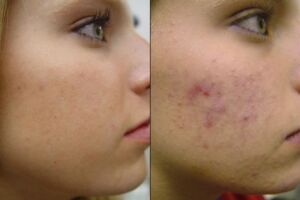Chemical peels improve the appearance of mild scarring by using a chemical solution to remove the outer layer of old skin. The new skin that replaces it is usually smoother and less irregular in appearance.
Why choose chemical peels for scars
Chemical peels offer a relatively inexpensive option for improving the appearance of scars. Fair-skinned and light-haired patients are better candidates for the procedure.
Possible risks
As with any treatment, there are risks associated with it, though they are minimized in the hands of a qualified ASDS dermatologist. These include:
- Â Â Â Temporary or permanent change in skin color, particularly for women on birth control pills who subsequently become pregnant or have a history of brownish facial discoloration.
- Â Â Â Scarring.
- Â Â Â Reactivation of cold sores.
What you should know about chemical peels for scars
The skin is cleansed, and then one or more chemical solutions are applied. These applications produce a controlled wound, enabling new, regenerated skin to appear. Most patients experience a burning sensation that lasts about five to 10 minutes, followed by a stinging sensation. Cool compresses may be applied to help alleviate this stinging. A deeper peel may require pain medication during or after the procedure.
What to expect after the procedure
Afterward, patients experience a reaction similar to sunburn in the treatment area. Patients may experience:
- Redness, followed by scaling within three to seven days.
- Swelling.
- Blisters that will crust, turn brown and peel off within seven to 14 days following medium and deep peels.
- Bandages over treated areas for several days.
- Chemical peel patients should avoid the sun for several months following a procedure.
- Light peels may be repeated in one- to four-week intervals. Medium-depth peels may be repeated ever six to 12 months.
How to prepare for the procedure
Before the procedure, an ASDS dermatologist will usually review the patient’s medical history and conduct a physical exam. This is the time for the doctor and patient to discuss expectations, potential risks and outcomes of the procedure. Patients also should:
- Discuss your aging skin condition and your treatment goals in order to determine the depth of chemical peel.
- Reveal any history of scarring, persistent cold sores or facial X-rays.
- Avoid any medications or supplements that can affect blood clotting – such as aspirin, ibuprofen or vitamin E – for 10 days before surgery.
- Avoid using medications such as Retin-A, Renova or glycolic acid.
- Determine in advance whether you will need to have someone drive you home following the procedure.

